2. 南方海洋科学与工程广东省实验室(广州), 广州 511458;
3. 中国建筑科学研究院, 北京 100013;
4. 长江三峡勘测研究院有限公司(武汉), 武汉 430074
2. Southern Marine Science and Engineering Guangdong Laboratory(Guangzhou), Guangzhou 511458, China;
3. China Academy of Building Research, Beijing 100013, China;
4. Three Gorges Geotechnical Consultants Co., Ltd., Wuhan 430074, China
大地热流的研究历来是板块构造研究的核心内容.在板块构造的确立中,大西洋洋脊两侧的热流随着板块年龄的增加而降低,这为板块构造理论提供了重要的证据(Larsen et al., 2018; Marcus et al., 1966);在各个海域和大陆区域的构造动力学研究中(Li, 2011;Cloetingh, 2006),区域热流及板块热结构的研究是不可或缺的重要组成部分.岩石圈热结构是指一个地区壳、幔两部分热流的配分比例及其组构关系(Blackwell, 1971).壳、幔热流配分影响到现今地壳、上地幔的活动性及深部温度状况,尤其地幔热流能从本质上表征某一地区的构造活动性与板块构造的密切关系.通过对其深入研究可以获得板块构造、盆地发育和岩浆活动的响应.
南海经历了海底板块生长、消减和岩浆溢出等过程(图 1),而岩石圈变形和岩浆作用是其核心内容,它们与岩石圈的深部热状态和深部热结构密切相关.因此,研究南海深部“热”岩石圈结构与其深部构造的动态响应具有非常重要的意义.前人做了大量的研究工作,施小斌等通过592个热流数据勾画出南海热流分布(姚伯初,2006;饶春涛和李平鲁,1991;饶春涛,1994);何丽娟等根据584个热流数据,通过一维热传导方法获得了南海热岩石圈厚度的整体框架,并发现南海海盆的热流基本满足随洋壳年龄增加而降低的规律和中沙—西沙地区属于中等偏高热流区(何丽娟等,1998;He et al.,2001;施小斌等,2003);在南海北部陆缘,洋-陆过渡带的热流高于陆缘一倍,是海底火成岩喷发影响所致(Anderson,1978);对南海西部海域,认为从西沙海槽到琼东南海盆中部NE向存在高热流带,这条热流高带主要和南海西沙和中沙海槽拉张破裂有关,是深部热流上涌的结果(徐行等,2006).这些成果为我们认识南海深部热结构和板块构造提供非常有利的研究基础.但南海深部热状态、热结构和板块构造的研究并不是很多,限于资料的原因,大多数成果建立在离散的点或者剖面的研究(Ru and Pigott, 1986;Su et al., 1989;Nissen et al., 1995;张健和汪集旸, 2000;Clift et al.,2002;Lin and Watts, 2002;马辉等, 2012;Zhao et al., 2018),其主要成果也只是对海底热流变化特征、控制因素和各个构造单元之间的差异做定性的讨论,对壳幔的热流比例、莫霍面温度、“热”岩石圈底界及其温度做一维或二维剖面的计算(张健和汪集旸,2000;施小斌等, 2000, 2003;汪集旸,2015;胡圣标等. 2019;Clift et al,2002).而今,随着我国南海深水油气、天然气水合物资源勘探和海洋强国政策的推进,地热探针技术的自主研发,海底热流测量取得了大规模的成果(米立军等,2009;李亚敏等,2010;徐行等,2005; 2006;2011;2012;2018),见图 2.为我们深入研究南海深部热结构提供非常有利的契机,与此同时南海深部大计划自2011年实施以来,开展了海底地磁学、深部地球物理、构造地质和火山活动等学科的探测与研究,这些研究有助于进一步认识南海的形成年龄、深部结构和物质组成,但由于缺乏对南海现今热状态和热结构三维整体趋势的分析和研究,尚不能完整认识南海区域构造演化、盆地发育和岩浆活动特征.随着计算机3D模拟飞速发展,也亟待从2D发展到3D角度去认识南海深部热结构,本文试图通过积累的整个南海热流数据(图 2),反演热岩石圈底部边界的埋深,从南海三维岩石圈热结构、壳幔比和地表构造等揭示南海板块构造、盆地发育和岩浆活动特点.

|
图 1 南海地形及其周边构造单元 红色虚线是断层分布(孙珍等,2005);黑色虚线是沉积盆地范围(珠江口盆地、莺歌海盆地、中建南盆地、南薇西盆地以及珠江口盆地内的顺德凹陷、白云主凹和白云南凹). Fig. 1 Topography of the South China Sea and its surrounding structural units The red dashed line is the faults (Sun et al., 2005); the black dashed line is the sedimentary basins (Pearl River Mouth Basin, Yinggehai Basin, Zhongjian South Basin, Nanweixi Basin, as well as the Shunde Sag, Baiyun main Sag and Baiyun South Sag in the Pearl River Mouth Basin). |
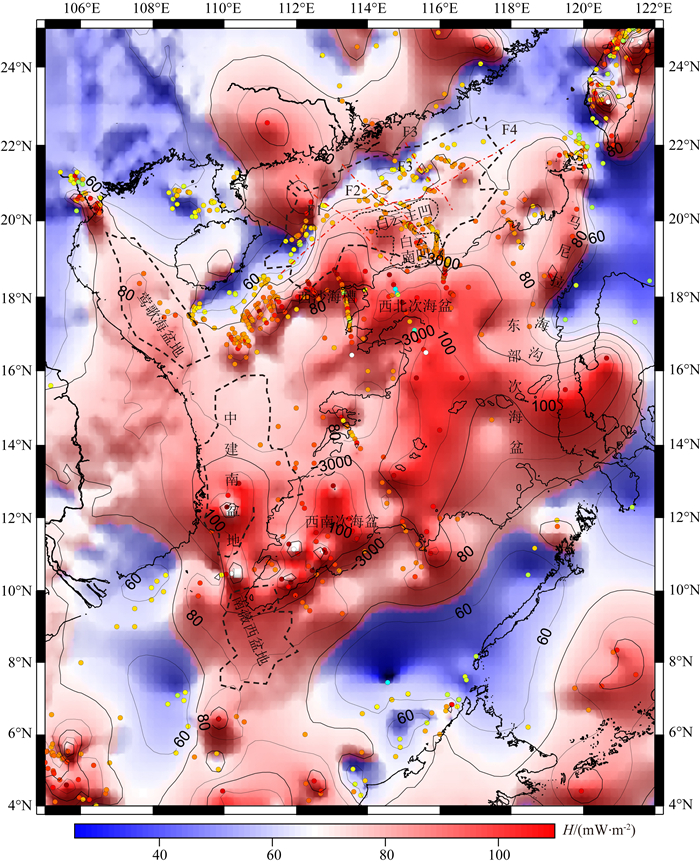
|
图 2 南海热流分布(米立军等, 2009; 徐行等, 2005, 2006, 2018; Xu et al., 2011; 饶春涛和李平鲁, 1991; http://www.heatflow.org/thermoglobe/map) 黑色粗线表示3000 m水深线和海岸线,黑色细线为热流等值线,圆点为热流站位. Fig. 2 The heat flow distribution in the South China Sea (Mi et al., 2009; Xu et al., 2005, 2006, 2018; Xu et al., 2011; Rao and Li, 1991; http://www.heatflow.org/thermoglobe/map) The thick black line represents the 3000-meter isobaths and coastline, the thin black line represents the heat flow contour, and the dots represent the heat flow sites. |
根据南海地形和磁异常的分布特点,南海分为西北次海盆、东部次海盆和西南次海盆(Briais et al.,1993).其四周被不同类型的大陆边缘所包围:东部沿着马尼拉海沟被分成两段,北段南海板块向菲律宾群岛俯冲,南段受南海板块和菲律宾板块的双向俯冲(瞿辰等,2007);南部为礼乐滩、南沙群岛和南沙海槽,在海底扩张过程中与婆罗洲发生了陆陆碰撞挤压作用;西部以呈右旋走滑的红河断裂带为界与印支半岛相邻,沿线分布着莺歌海盆地、西沙海槽、中建南盆地和南薇西盆地,其中红河—越东断裂带后期的右旋走滑影响了莺歌海盆地的形成,并主导了其走向(崔涛,2008).西沙海槽沉积基底起伏较大,沉积厚度l~4 km,与莺歌海盆地相比, 其沉积较薄.西沙海槽有大量新生代晚期的岩浆和火山活动,形成了明显的局部重、磁异常和高热流值(Nissen et al., 1995);北部陆缘发生了大规模的地壳拉张、减薄作用,形成了一系列张性盆地,珠江口盆地位于南海北部陆缘中部海区,主要经历了华南陆缘的裂谷拉张过程.中中新世以来,受到菲律宾海板块的挤压碰撞(Biq,1978).南海东部在台湾与西菲律宾海发生洋壳俯冲、陆陆碰撞;在马尼拉海沟,南海海盆向吕宋岛下俯冲(Taylor and Hayes, 1980). 这种俯冲和碰撞造成南海东北部陆缘向西挤压走滑,以及沿断裂发生新近纪岩浆和火山活动(Lüdmann and Wong, 1999;李家彪等. 2011;Ho et al., 2000).
2 数据和模型 2.1 热流数据根据目前在南海及其周边地区积累的1227个海底热流分布(图 2),发现其高热流值(约90~120 mW·m-2)主要集中在南海北部陆缘珠江入海口西侧、西北次海盆、东部次海盆西侧、南海残余洋中脊(磁异常C5Dr)及其东向沿线的吕宋岛区域、西南次海盆和中建南盆地,特别有意思的是南海西南次海盆被分割成东、西两部分,与有、无海山的分布恰好一致,西部红河断裂带沿线的莺歌海盆地、南薇西盆地、西沙海槽、中-西沙群岛和东沙群岛的热流略低于海盆区(大约70~90 mW·m-2).南海周边陆壳热流值小于70 mW·m-2.这些热流数据为我们深入研究南海岩石圈三维热结构提供非常有利的数据基础.
2.2 模型和边界条件根据多波束测深、重、磁和地震反演得到的水深、基底、莫霍面(Li et al., 2010;2012)和岩石圈底界数据(Yu et al., 2017; Tang and Zheng, 2013)建立了三维几何模型(图 3).采用Comsol三维模拟软件模拟实测海底热流,热传导方程见公式(1).发现其与实测海底热流数据相差较大(见图 4a),于是通过改变岩石圈底界深度使模拟热流与实测海底热流数据相吻合,得到热岩石圈底界的深度分布,模拟计算海底热流与实测热流的差值见图 4b.

|
(1) |
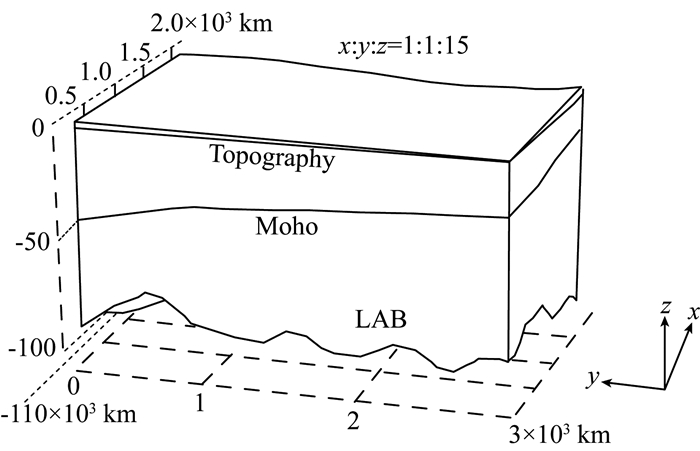
|
图 3 三维几何模型 Fig. 3 Three-dimensional geometric model |
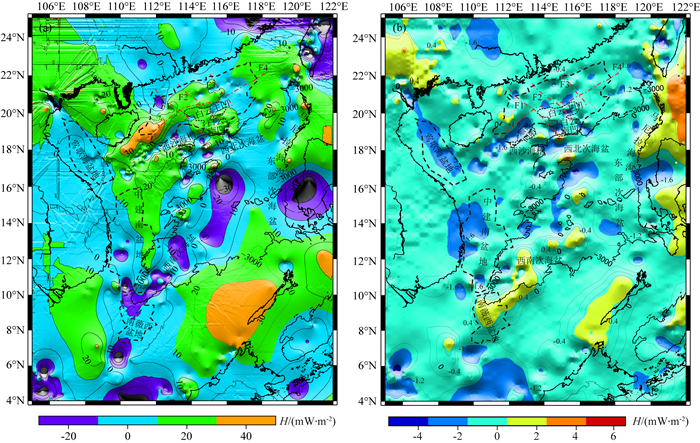
|
图 4 模拟计算海底热流与实测热流的差值 (a) 以地震反演岩石圈底部边界(Yu et al., 2017,Tang and Zheng, 2013)为约束模拟的热流与实测热流差值;(b) 本文拟合实测海底热流的结果.黑色粗曲线表示3000 m等深线和海岸线,黑色细曲线表示模拟得到的海底热流与实测热流的差值的等值线 Fig. 4 Difference between the modelled and measured heat flow (a) The modelled heat flow constrained by the seismic wave inversed lithosphere-asthenosphere boundary, see Yu et al., 2017 and Tang and Zheng, 2013; (b) The modelled heat flow on basis of the lithosphere-asthenosphere boundary derived by fitting the measured heat flow.The thick black line represents the 3000-meter isobaths and coastline, the thin black line represents the heat flow contours of the difference between modelled and measured. |
其中,A表示生热率,T表示温度,k是热导率, 几何模型四边处于绝热状态,海底温度选取10 ℃,岩石圈底部边界温度选取1330 ℃(陈凌等,2007;胡立天,2019).
|
|
表 1 主要模拟参数 Table 1 Parameters used in the modelling |
根据三维数值模拟得到的南海及周边地区的三维热岩石圈底部边界的埋深(见图 5a).发现南海热岩石圈底部边界的深度为30~100 km,最薄区域集中在南海西北次海盆、西南次海盆、东部次海盆西侧、南海北部陆缘中部、莺歌海盆地、中建南盆地、南薇西盆地、沿马尼拉海沟东北段和沿残余扩张脊延伸方向的吕宋岛弧,热岩石圈底部边界在30~70 km.其中,西南次海盆明显分成东、西两部分,东部与残余扩张脊(海山的分布)一致,并与东部次海盆相连,西部与中建南盆地相邻,西南部和南薇西盆地结合在一起,表现为减薄的岩石圈结构.东部次海盆沿55 km的岩石圈等深线也被分成东、西两部分,西部与西北次海盆和西南次海盆一致表现出减薄的岩石圈,东部明显增厚,热岩石圈底部边界埋深在55~80 km之间.西北次海盆与中、西沙海槽、中沙海台、珠江口盆地相连,岩石圈减薄明显.特别是在珠江口盆地内出现超薄岩石圈厚度,与断裂带(F1, F2、F3和F4)和凹陷(顺德凹陷、白云主凹和白云南凹)分布一致.其他地区的热岩石圈底部边界埋深基本在70~100 km之间.通过对比本文计算的三维热岩石圈底部边界埋深与一维反演得到的热岩石圈底部边界埋深(图 5),发现二者在整体的分布格局上近似,特别是海盆区,大约都在40 km以内,体现了地幔对海底热流的主要贡献,但从等深线分布来看,本文计算的三维热岩石圈底部边界埋深明显比一维反演得到热岩石圈底部边界埋深浅(大约5~10 km),而且本文得到热岩石圈底部边界受地形、基底和Moho面各圈层地形分布的影响,呈现出明显的高低起伏的地形分布特征,而一维热岩石圈底部边界分布相对平坦.同时由于热流数据的积累,我们得到了更为精细的西沙海槽,莺歌海盆地、中建南盆地、西北次海盆和西南次海盆的热岩石圈底部边界埋深.
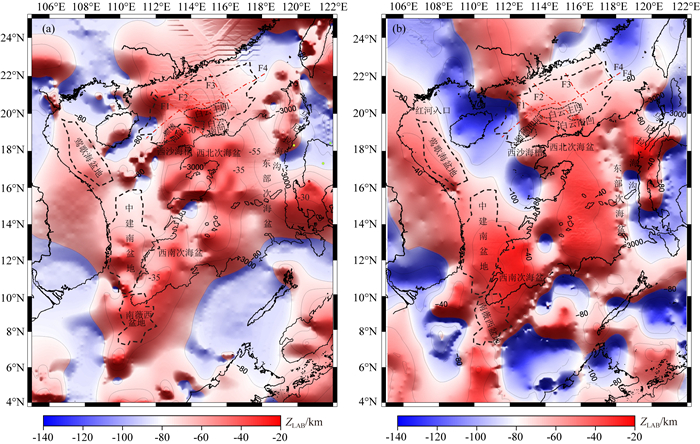
|
图 5 南海及周边地区三维(a)和一维(b)热岩石圈底界埋深 黑色粗曲线表示3000m水深线和海岸线,黑色细线表示热岩石圈底界埋深等值线. Fig. 5 The depth of the lithosphere-asthenosphere boundary derived from the 3D (a) and 1D (b) modelling in the South China Sea and its surrounding areas The thick black line represents the 3000-meter isobaths and coastline, the thin black line represents the depth contour of the Lithosphere-Asthenosphere Boundary. |
为了验证我们计算结果的可靠性,将本文的热岩石圈底部边界埋深(图 5a)与地震波反演得到的岩石圈底部边界埋深(图 6a, Yu et al., 2017, Tang and Zheng, 2013)对比,并做差值(见图 6b),发现除个别区域埋藏比较深,图 6b中深蓝色(可能与计算误差或者测得的热流数据分布不均有关,我们可以取前人的结果作为参考),大部分区域基本相近或者比地震波反演的结果埋藏浅.对于接近的结果,我们认为是可靠的.而埋藏浅的结果,主要分布在珠江入海口周边地区、西北次海盆部分以及向南直到西南次海盆,包括中建南盆地和南薇西盆地、莺歌海盆地和沿大型海山分布(磁异常识别的洋中脊)与吕宋岛弧相交区域(119°E—122°E和13°N—17°N),见图 6b的深绿色和黄色区域,其中珠江入海口周边地区与Huang等(2014;2015)、Xia等(2018)计算的地震层析成像的结果相近.莺歌海盆地和区域119°E—122°E和13°N—17°N与MITP08全球速度模型(Li et al., 2008)得到结果一致.而其他区域的情况可能与热岩石圈底部边界埋深比地震层析成像得到的岩石圈底部边界埋深浅(陈凌等,2007)的观点有关.

|
图 6 南海及其周边地区根据地震波计算的岩石圈底界深度(Yu et al., 2017,Tang and Zheng, 2013)(a)和与本文模拟计算热岩石圈底界深度的差值(b) 黑色粗线表示3000m水深线和海岸线,黑色细线表示热岩石圈底界埋深等值线. Fig. 6 The depth of the seismic wave inversed Lithosphere-Asthenosphere Boundary (LAB) in the South China Sea and its surrounding areas (Yu et al., 2017, Tang and Zheng, 2013) (a) and the difference between the seismic wave inversed LAB and the modelled LAB in this paper (b) The thick black line represents the 3000-meter isobaths and coastline, the thin black line represents the contour of the Lithosphere-Asthenosphere Boundary. |
根据三维热岩石圈结构和壳、幔热流的分布特点,我们得到了南海及其周边地区海底热流的壳幔贡献比(图 7).从图中可以看出南海海盆(3000 m水深)、中建南盆地南部、南薇西盆地和西沙海槽的壳、幔比小于0.1,从海盆区边界(大约3000 m水深)到大陆破裂边缘介于0.1~0.2之间,陆壳基本介于0.2~0.5之间.
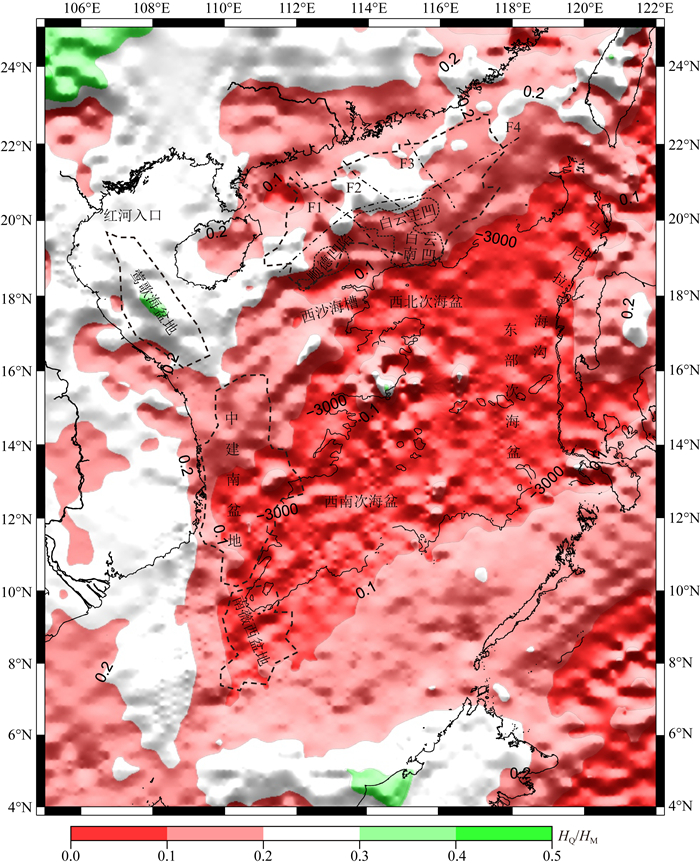
|
图 7 南海及其周边地区海底热流壳、幔贡献比 黑色粗线表示3000 m水深线和海岸线,黑色细线表示热岩石圈底界埋深等值线. Fig. 7 The crust-mantle heat flow contribution ratio in the South China Sea and surrounding areas The thick black line represents the 3000-meter isobaths and coastline, the thin black line represents the contour of the crust-mantle heat flow contribution ratio. |
在南海西缘,通过莺歌海盆地、中建南盆地和南薇西盆地的热岩石圈底部边界埋深、海底热流和地表形态的分布对比,发现它们具有很好的相关性,特别是中建南盆地(高红芳和陈玲,2006)和南薇西盆地地表形态与深部结构的分布非常一致,见图 1、图 5a和图 7,而莺歌海盆地虽与深部结构有关,但明显不一致,可能与红河断裂带左旋走滑形成的拉分盆地有关(郭令智等, 2001;龚再升等, 1997; 李思田等, 1998; Allen et al., 1984; Leloup et al., 1995; Sun et al., 2003).
在南海中部,以珠江入海口和珠江口盆地为中心的南海北部陆缘呈现热流高和岩石圈底部边界埋藏浅的特征,其中珠江入海口周边地区热岩石圈结构与地震层析成像结果一致(Xia et al.,2018;Huang, 2014; Huang et al.,2015),珠江口盆地热岩石圈结构与孙珍等(2005)识别的断层和凹陷分布位置一致,特别是白云主凹、白云南凹和顺德凹陷都对应特别高的热流值和比较浅的岩石圈底部边界埋深,这可能与扩张后期岩浆活动和沿断层带的岩浆活动有关(Zhao et al., 2016).西沙海槽、西北次海盆、和东部次海盆西侧也表现出比较高的热流值和比较浅的岩石圈底部边界埋深,特别是西沙海槽深部热岩石圈结构与地表形态具有镜像对称的分布特点,表现出深部构造对地表的控制作用.而西南次海盆海底热流分布和热岩石圈底部埋深都被明显分成两半,东侧与东部次海盆西南部相连,与磁异常识别的洋中脊分布一致,表现为大型海山,说明有同样的深部构造属性.根据中南海山及毗邻东部次海盆的珍贝海山和涨中海山的玄武岩形成年龄(9~7 Ma)和岩石地球化学性质均属OIB碱性玄武岩,认为与海底扩张后南海周缘大量岩浆活动的规律一致(Xu et al., 2012; Yan et al., 2014),表明海底扩张期和扩张停止后岩浆活动强烈,岩浆供应量较充足(丁航航等,2019).西侧表明岩浆作用较弱,洋壳形成过程中更多表现裂谷作用的特征,基底主要为构造伸展为主导的断块类型和深大断裂发育(Li et al., 2012; Ding and Li, 2016).西南次海盆在海底扩张动力背景下叠加了强烈的构造拉伸作用,具有明显的构造主导型海底扩张的特点,预示着海盆地壳结构在时空上可能发生改变,可能从正常洋壳过渡到超薄洋壳或蛇纹石化橄榄岩的异常地幔(丁航航等,2019).但被分成两部分的西南次海盆都表现为较高的热流值和比较浅的热岩石圈底部边界埋深.在南海东部,马尼拉海沟东北段呈现出较高热流值和较浅的热岩石圈底部边界埋深,中段则相反,而沿大型海山分布(磁异常识别的洋中脊)与吕宋岛弧相交区域(119°E—122°E和13°N—17°N)呈现比较高热流值和比较浅的热岩石圈底部边界埋深.东部次海盆被分成东、西两部分,西侧与西南次海盆和西北次海盆相连,呈现比较高的热流值和比较浅的热岩石圈底部边界埋深,而东侧呈现比较低的热流值和比较深的热岩石圈底部边界埋深,这可能与南海和古南海的俯冲有一定的相关性(Wu and Suppe, 2018;Sun et al.,2019).
5 总结(1) 南海三维热岩石圈底界埋深与一维反演得到热岩石圈底界埋深的整体的分布近似,特别是海盆区西侧,大约都在40 km以内,体现了地幔对海底热流的主要贡献.但从等深线分布来看,本文计算的三维热岩石圈底部边界埋深明显比一维反演得到热岩石圈底部边界埋深浅(大约5~10 km),而且本文得到热岩石圈底部边界埋深受地形、基底和Moho面各圈层地形分布的影响,呈现出明显的高低起伏的地形分布特征,而一维反演得到的热岩石圈底界埋深相对平坦.
(2) 根据南海及其周边地区的海底热流的壳幔贡献比,南海海盆(3000 m水深)、中建南盆地南部、南薇西盆地和西沙海槽的部分的壳幔比小于0.1,说明其海底热流主要由地幔贡献.从海盆区边界(大约3000 m水深)到大陆破裂边缘壳幔比介于0.1~0.2之间,陆壳基本介于0.2~0.5之间,说明海底热流的20%~50%来自地壳.
(3) 通过南海三维热岩石圈结构的数值模拟,发现南海深部热岩石圈结构和地表的不同构造单元有镜像对称的响应关系.如西沙海槽、西北次海盆、东部次海盆西侧、西南次海盆、中建南盆地和南薇西盆地的地表形态基本受深部热岩石圈结构的控制.莺歌海盆地虽与深部构造有关,但明显不一致,可能与红河断裂带左旋走滑形成的拉分盆地有关.以珠江入海口和珠江口盆地为中心的南海北部陆缘呈现特别高的热流值和岩石圈底界埋藏浅的特征,特别是白云主凹、白云南凹和顺德凹陷,可能与扩张停止后的岩浆活动和沿断层带的岩浆活动有关.
(4) 南海深部热岩石圈结构与板块构造密切相关.西南次海盆和东部次海盆的深部热岩石圈底部边界埋深都被分成东、西两部分,西南次海盆与东部次海盆相连部分,表现为大型海山和很强的岩浆活动,说明有同样的深部构造属性,西南次海盆西侧表现出较弱的岩浆作用,海底扩张以构造裂谷作用为主导.东部次海盆东侧呈现热流低和热岩石圈底部边界埋深更深的特点,而沿马尼拉海沟的东北端呈现较高的热流值和浅的热岩石圈底部边界埋深,可能与南海和古南海的俯冲有关.在119°E—122°E和13°N—17°N区呈现较高的热流值和浅的热岩石圈底部边界埋深,可能与南海板块和菲律宾海板块的双向俯冲有关.
Allen C R, Gillespie A R, Yuan H, et al. 1984. Red River and associated faults, Yunnan Province, China: Quaternary geology, slip rates, and seismic hazard. GSA Bulletin, 95(6): 686-700. DOI:10.1130/0016-7606(1984)95<686:RRAAFY>2.0.CO;2 |
Anderson R N, Langseth M G, Hayes D E, et al. 1978. Heat flow, thermal conductivity. A Geophysical Atlas of east and southeast Asian Seas, Char Ser. MC-25. Hayes ed. Geol. Soc. of Am. Boulder, Colo., USA, pp. 1-125.
|
Biq C. 1978. Taiwan vis-a-vis New Guinea: A comparison of their continent-arc collisions. Acta Oeeanographiea Taiwanica, 8: 22-42. |
Blackwell D D. 1971. The thermal structure of the continental crust. //Heacock J G ed. The Structure and Physical Properties of the Earth's Crust. Washington, D. C. : American Geophysical Union, 169-184.
|
Briais A, Patriat P, Tapponnier P. 1993. Updated interpretation of magnetic anomalies and seafloor spreading stages in the South China Sea: implications for the tertiary tectonics of Southeast Asia. Journal of Geophysical Research: Solid Earth, 98(B4): 6299-6328. DOI:10.1029/92JB02280 |
Chen L, Zhu R X, Wang T. 2007. Progress in continental lithosphere studies. Earth Science Frontiers (in Chinese), 14(2): 58-75. |
Clift P, Lin J, Barckhausen U. 2002. Evidence of low flexural rigidity and low viscosity lower Continental crust during continental break-up in the South China Sea. Marine and Petroleum Geology, 19(8): 951-970. DOI:10.1016/S0264-8172(02)00108-3 |
Cloetingh S, Ziegler P A, Beekman F, et al. 2006. Thermo-mechanical controls on Alpine deformation of NW Europe. Geological Society London Memoirs, 32(1): 113-127. DOI:10.1144/GSL.MEM.2006.032.01.07 |
Cui T, Xie X N, Ren J Y, et al. 2008. Dynamic mechanism of anomalous post-rift subsidence in the Yinggehai basin. Earth Science-Journal of China University of Geosciences (in Chinese), 33(3): 349-356. DOI:10.3799/dqkx.2008.046 |
Ding H H, Ding W W, Fang Y X. 2019. Morphological Characteristics and control factors of oceanic basement in the Southwest Sub-Basin, South China Sea. Earth Science Frontiers (in Chinese), 26(2): 222-232. DOI:10.13745/j.esf.sf.2019.1.15 |
Ding W W, Li J B. 2016. Propagated rifting in the Southwest Sub-basin, South China Sea: Insights from analogue modelling. Journal of Geodynamics, 100: 71-86. DOI:10.1016/j.jog.2016.02.004 |
Gao H F, Chen L. 2006. An analysis of structural framework and formation mechanism of Zhongjiannan basin in the west of South China Sea. Oil & Gas Geology (in Chinese), 27(4): 512-516. |
Gong Z S, Li S T, Xie T J, et al. 1997. Continental Margin Basin Analysis and Hydrocarbon Accumulation of the Northern South China Sea (in Chinese). Beijing: Science Press: 193-256.
|
Guo L Z, Zhong Z H, Wang L S, et al. 2001. Regional tectonic evloution around Yinggehai Basin of South China Sea. Geological Journal of China Universities (in Chinese), 7(1): 1-12. |
He L J, Xiong L P, Wang J Y. 1998. Effects on the tectonothermal modeling of extensional basins. Scientia Geologica Sinica (in Chinese), 33(2): 222-228. |
He L J, Wang K L, Xiong L P, et al. 2001. Heat flow and thermal history of the South China Sea. Physics of the Earth and Planetary Interiors, 126(3-4): 211-220. DOI:10.1016/S0031-9201(01)00256-4 |
Ho K S, Chen J C, Juang W S. 2000. Geochronology and geochemistry of late Cenozoic basalts from the Leiqiong area, southern China. Journal of Asian Earth Sciences, 18(3): 307-324. DOI:10.1016/S1367-9120(99)00059-0 |
Hu L T, Zhang P Z, Hao T Y, et al. 2019. The lithospheric structure in the Southwest Subbasin, South China Sea and its Geological implication. Chinese Journal of Geophysics (in Chinese), 62(9): 3464-3481. DOI:10.6038/cjg2019M0559 |
Hu S B, Long Z L, Zhu J Z, et al. 2019. Characteristics of Geothermal Field and the Tectonic-thermal Evolution in Pearl River Mouth Basin. Acta Petrolei Sinica (in Chinese), 40(S1): 178-187. |
Huang H B, Tosi N, Chang S J, et al. 2015. Receiver function imaging of the mantle transition zone beneath the South China Block. Geochemistry, Geophysics, Geosystems, 16(10): 3666-3678. DOI:10.1002/2015GC005978 |
Huang J L. 2014. P-and S-wave tomography of the Hainan and surrounding regions: Insight into the Hainan plume. Tectonophysics, 633: 176-192. DOI:10.1016/j.tecto.2014.07.007 |
Lüdmann T, Wong H K. 1999. Neotectonic regime on the passive continental margin of the northern South China Sea. Tectonophysics, 311(1-4): 113-138. DOI:10.1016/S0040-1951(99)00155-9 |
Larsen H C, Mohn G, Nirrengarten M, et al. 2018. Rapid transition from continental breakup to igneous oceanic crust in the South China Sea. Nature Geoscience, 11(10): 782-789. DOI:10.1038/s41561-018-0198-1 |
Leloup P H, Lacassin R, Tapponnier P, et al. 1995. The Ailao shan-Red River shear zone (Yunnan, China), Tertiary transform boundary of Indochina. Tectonophysics, 251(1-4): 3-10, 13-84. DOI:10.1016/0040-1951(95)00070-4 |
Li C, Van Der Hilst R D, Engdahl R D, et al. 2008. A new global model for P wave speed variations in Earth's mantle. Geochemistry, Geophysics, Geosystems, 9(5): Q05018. DOI:10.1029/2007GC001806 |
Li C F. 2011. An integrated geodynamic model of the Nankai subduction zone and neighboring regions from geophysical inversion and modeling. Journal of Geodynamics, 51(1): 64-80. DOI:10.1016/j.jog.2010.08.003 |
Li J B, Ding W W, Gao J Y, et al. 2011. Cenozoic evolution model of the sea-floor spreading in South China sea: New constraints from high resolution geophysical data. Chinese Journal of Geophysics (in Chinese), 54(12): 3004-3015. DOI:10.3969/J.issn.0001-5733.2011.12.003 |
Li J B, Ding W W, Wu Z Y, et al. 2012. The propagation of seafloor spreading in the southwestern subbasin, South China Sea. Chinese Science Bulletin, 57(24): 3182-3191. DOI:10.1007/s11434-012-5329-2 |
Li S L, Meng X H, Guo L H, et al. 2010. Gravity and magnetic anomalies field characteristics in the South China Sea and its application for interpretation of igneous rocks. Applied Geophysics, 7(4): 295-305. DOI:10.1007/s11770-010-0258-9 |
Li S L, Li Y G, Meng X H. 2012. The 3D magnetic structure beneath the continental margin of the northeastern South China Sea. Applied Geophysics, 9(3): 237-246. DOI:10.1007/s11770-012-0334-4 |
Li S L, Li Y G. 2012. Inversion of magnetic anomaly affected by strong remanent Magnetization over rugged terrain: A case study from Daye, China. //82nd Ann. Internat Mtg., Soc. Expi. Geophys. . Expanded Abstracts, doi: 10.1190/segam2012-0515.1.
|
Li S T, Lin C S, Zhang Q M, et al. 1998. Episodic rifting of continental marginal basins and tectonic events since 10 Ma in the South China Sea. Chinese Science Bulletin, 44(1): 10-23. |
Li Y M, Luo X H, Xu X, et al. 2010. Seafloor in-situ heat flow measurements in the deep-water area of the Northern Slope, South China Sea. Chinese Journal of Geophysics (in Chinese), 53(9): 2161-2170. DOI:10.3969/j.issn.0001-5733.2010.09.016 |
Lin A T, Watts A B. 2002. Origin of the West Taiwan basin by orogenic loading and flexure of a rifted continental margin. Journal of Geophysical Research: Solid Earth, 107(B9): 2185. |
Luo J L, He M, Pang X, et al. 2019. Diagenetic response on thermal evolution events and high geothermal gradients in the southern pear river mouth basin and its enlightenment to hydrocarbon exploration. Acta Petrolei Sinica (in Chinese), 40(S1): 90-104. |
Ma H, Xu H H, Zhao J F, et al. 2012. Thermal structure of Nansha Trough Foreland Basin. Journal of Tropical Oceanography (in Chinese), 31(3): 155-161. |
Mi L J, Yuan Y S, Zhang G C, et al. 2009. Characteristics and genesis of geothermal field in deep-water area of the northern South China Sea. Acta Petrolei Sinica (in Chinese), 30(1): 27-32. |
Nissen S S, Hayes D E, Yao B C, et al. 1995. Gravity, heat flow, and seismic constraints on the processes of crustal extension: northern margin of the South China Sea. Journal of Geophysical Research: Solid Earth, 100(B11): 22447-22483. DOI:10.1029/95JB01868 |
Qu C, Zhou H L, Zhao D P. 2007. Deep structure beneath the west margin of Philippine Sea Plate and South China Sea from P and S wave travel time tomography. Chinese Journal of Geophysics (in Chinese), 50(6): 1757-1768. DOI:10.3321/j.issn:0001-5733.2007.06.016 |
Rao C T, Li P L. 1991. Study of heat flow in Pearl River mouth basin. China Offshore Oil and Gas (Geology) (in Chinese), 5(6): 7-18. |
Ru K, Pigott J D. 1986. Episodic rifting and subsidence in the South China Sea. AAPG Bulletin, 70(9): 1136-1155. |
Shi X B, Zhou D, Zhang Y X. 2000. Lithospheric thermal-rheological structures of the continental margin in the northern South China Sea. Chinese Science Bulletin, 45(22): 2107-2112. DOI:10.1007/BF03183537 |
Shi X B, Qiu X L, Xia K Y, et al. 2003. Heat flow characteristics and its tectonic significance of South China Sea. Journal of Tropical Oceanography (in Chinese), 22(3): 63-73. |
Shi X B, Wang Z F, Jiang H Y, et al. 2015. Vertical variations of geothermal parameters in rifted basins and heat flow distribution features of the Qiongdongnan Basin. Chinese Journal of Geophysics (in Chinese), 58(3): 939-952. DOI:10.6038/cjg20150320 |
Su D Q, White N, McKenzie D. 1989. Extension and subsidence of the Pearl River mouth basin, northern South China Sea. Basin Research, 2(4): 205-222. DOI:10.1111/j.1365-2117.1989.tb00036.x |
Sun Z, Zhou D, Zhong Z H, et al. 2003. Experimental evidence for the dynamics of the formation of the Yinggehai basin, NW South China Sea. Tectonophysics, 372(1-2): 41-58. DOI:10.1016/S0040-1951(03)00230-0 |
Sun Z, Pang X, Zhong Z H, et al. 2005. Dynamics of tertiary tectonic evolution of the Baiyun Sag in the Pearl River Mouth basin. Earth Science Frontiers (in Chinese), 12(4): 489-498. |
Sun Z, Lin J, Qiu N, et al. 2019. The role of magmatism in thinning and breakup of the South China Sea continental margin. Natural Science Review, 6: 871-876. |
Tang Q S, Zheng C. 2013. Crust and upper mantle structure and its tectonic implications in the South China Sea and adjacent regions. Journal of Asian Earth Sciences, 62: 510-525. DOI:10.1016/j.jseaes.2012.10.037 |
Taylor B, Hayes D E. 1980. The tectonic evolution of the South China basin. //Hayes D E ed. The Tectonic and Geologic Evolution of Southeast Asian Seas and Islands. Washington, D. C. : American Geophysical Union, 89-104.
|
Wang J Y. 2015. Geothermics and Its Applications (in Chinese). Beijing: Science Press.
|
Wu J, Suppe J. 2018. Proto-South China sea plate tectonics using subducted slab constraints from tomography. Journal of Earth Science, 29(6): 1304-1318. DOI:10.1007/s12583-017-0813-x |
Xia S H, Zhao F, Zhao D P, et al. 2018. Crustal plumbing system of post-rift magmatism in the northern margin of South China Sea: New insights from integrated seismology. Tectonophysics, 744: 227-238. DOI:10.1016/j.tecto.2018.07.002 |
Xu X, Lu J A, Luo X H, et al. 2005. The marine heat flow survey and the result discussion in the northern part of South China Sea. Progress in Geophysics (in Chinese), 20(2): 562-565. DOI:10.3969/J.issn.1004-2903.2005.02.057 |
Xu X, Shi X B, Luo X H, et al. 2006. Heat flow measurements in the Xisha trough of the South China Sea. Marine Geology & Quaternary Geology (in Chinese), 26(4): 51-58. |
Xu X, He J X, He L J, Gong X F. 2011. Distribution of heat flow in Cenozoic basins of South China Sea and its connection with oil and gas migration and accumulation. Marine Geology & Quaternary Geology (in Chinese), 31(6): 99-108. |
Xu X, Li Y M, Luo X H, et al. 2012. Comparison of different-type heat flows at typical sites in natural gas hydrate exploration area on the northern slope of the South China Sea. Chinese Journal of Geophysics (in Chinese), 55(3): 998-1006. |
Xu X, Wang X Q, Peng D, et al. 2018. Characteristics and Research of Heat Flow in the Northwest Sub-Basin and Its Adjacent Areas of the South China Sea. Earth Science-Journal of China University of Geosciences (in Chinese), 43(10): 3391-3398. DOI:10.3799/dqkx.2017.606 |
Xu Y G, Wei J X, Qiu H N, et al. 2012a. Opening and evolution of the South China Sea constrained by studies on volcanic rocks: preliminary results and a research design. Chinese Science Bulletin, 57(24): 3150-3164. DOI:10.1007/s11434-011-4921-1 |
Yan Q S, Shi X F, Castillo P R. 2014. The late Mesozoic-Cenozoic tectonic evolution of the South China Sea: A petrologic perspective. Journal of Asian Earth Sciences, 85: 178-201. DOI:10.1016/j.jseaes.2014.02.005 |
Yao B C, Zeng W J, Hayes D E, et al. 1994. The Geological Memoir of South China Sea Surveyed Jointly by China & USA (in Chinese). Beijing: China University of Geosciences Press: 140.
|
Yao B C, Wan L, Zeng W J, et al. 2006. Three-dimensional Structure of Lithosphere and its Evolution in the South China Sea (in Chinese). Beijing: Geological Publishing House.
|
Yu C H, Shi X B, Yang X Q, et al. 2017. Deep thermal structure of Southeast Asia constrained by S-velocity data. Marine Geophysical Research, 38(4): 341-355. DOI:10.1007/s11001-017-9311-x |
Zhang J, Wang J Y. 2000. The deep thermal characteristic of continental margin of the northern South China Sea. Chinese Science Bulletin, 45(18): 1717-1722. DOI:10.1007/BF02898994 |
Zhao F, Alves T M, Wu S G, et al. 2016. Prolonged post-rift magmatism on highly extended crust of divergent continental margins (Baiyun Sag, South China Sea). Earth and Planetary Science Letters, 445: 79-91. DOI:10.1016/j.epsl.2016.04.001 |
Zhao Z X, Sun Z, Liu J B, et al. 2018. The continental extension discrepancy and anomalous subsidence pattern in the western Qiongdongnan Basin, South China Sea. Earth and Planetary Science Letters, 501: 180-191. DOI:10.1016/j.epsl.2018.08.048 |
Zhong G J, Gao H F. 2005. Sequence Characteristics of cenozoic stratigraphy in Zhongjiannan Basin, South China Sea. Geotectonica et Metallogenia (in Chinese), 29(3): 403-409. |
陈凌, 朱日祥, 王涛. 2007. 大陆岩石圈研究进展. 地学前缘, 14(2): 58-75. DOI:10.3321/j.issn:1005-2321.2007.02.005 |
崔涛, 解习农, 任建业, 等. 2008. 莺歌海盆地异常裂后沉降的动力学机制. 地球科学-中国地质大学学报, 33(3): 349-356. DOI:10.3321/j.issn:1000-2383.2008.03.008 |
丁航航, 丁巍伟, 方银霞. 2019. 南海西南次海盆基底形态特征及控制因素. 地学前缘, 26(2): 222-232. DOI:10.13745/j.esf.sf.2019.1.15 |
高红芳, 陈玲. 2006. 南海西部中建南盆地构造格架及形成机制分析. 石油与天然气地质, 27(4): 512-516. DOI:10.3321/j.issn:0253-9985.2006.04.011 |
龚再生, 李思田, 谢泰俊, 等. 1997. 南海北部大陆边缘盆地分析与油气聚集. 北京: 科学出版社: 193-256.
|
郭令智, 钟志洪, 王良书, 等. 2001. 莺歌海盆地周边区域构造演化. 高校地质学报, 7(1): 1-12. DOI:10.3969/j.issn.1006-7493.2001.01.001 |
何丽娟, 熊亮萍, 汪集旸. 1998. 拉张盆地多期构造热演化模拟中的影响因素. 地质科学, 33(2): 222-228. |
胡立天, 张培震, 郝天珧, 等. 2019. 南海西南次海盆岩石圈结构及其地质意义. 地球物理学报, 62(9): 3464-3481. DOI:10.6038/cjg2019M0559 |
胡圣标, 龙祖烈, 朱俊章, 等. 2019. 珠江口盆地地温场特征及构造-热演化. 石油学报, 40(S1): 178-187. DOI:10.7623/syxb2019S1015 |
李家彪, 丁巍伟, 高金耀, 等. 2011. 南海新生代海底扩张的构造演化模式: 来自高分辨率地球物理数据的新认识. 地球物理学报, 54(12): 3004-3015. DOI:10.3969/J.issn.0001-5733.2011.12.003 |
李思田, 林畅松, 张启明, 等. 1998. 南海北部大陆边缘盆地幕式裂陷的动力过程及10Ma以来的构造事件. 科学通报, 43(8): 797-810. DOI:10.3321/j.issn:0023-074X.1998.08.003 |
李亚敏, 罗贤虎, 徐行, 等. 2010. 南海北部陆坡深水区的海底原位热流测量. 地球物理学报, 53(9): 2161-2170. DOI:10.3969/j.issn.0001-5733.2010.09.016 |
马辉, 许鹤华, 赵俊峰, 等. 2012. 南沙海槽前陆盆地热结构. 热带海洋学报, 31(3): 155-161. |
米立军, 袁玉松, 张功成, 等. 2009. 南海北部深水区地热特征及其成因. 石油学报, 30(1): 27-32. DOI:10.3321/j.issn:0253-2697.2009.01.005 |
瞿辰, 周蕙兰, 赵大鹏. 2007. 使用纵波和横波走时层析成像研究菲律宾海板块西边缘带和南海地区的深部结构. 地球物理学报, 50(6): 1757-1768. DOI:10.3321/j.issn:0001-5733.2007.06.016 |
饶春涛, 李平鲁. 1991. 珠江口盆地热流研究. 中国海上油气(地质), 5(6): 7-18. |
施小斌, 周蒂, 张毅祥. 2000. 南海北部陆缘岩石圈热-流变结构. 科学通报, 45(15): 1660-1665. DOI:10.3321/j.issn:0023-074X.2000.15.017 |
施小斌, 丘学林, 夏戡原, 等. 2003. 南海热流特征及其构造意义. 热带海洋学报, 22(2): 63-73. DOI:10.3969/j.issn.1009-5470.2003.02.007 |
施小斌, 王振峰, 蒋海燕, 等. 2015. 张裂型盆地地热参数的垂向变化与琼东南盆地热流分布特征. 地球物理学报, 58(3): 939-952. DOI:10.6038/cjg20150320 |
孙珍, 庞雄, 钟志洪, 等. 2005. 珠江口盆地白云凹陷新生代构造演化动力学. 地学前缘, 12(4): 489-498. DOI:10.3321/j.issn:1005-2321.2005.04.018 |
汪集旸. 2015. 地热学及其应用. 北京: 科学出版社.
|
徐行, 陆敬安, 罗贤虎, 等. 2005. 南海北部海底热流测量及分析. 地球物理学进展, 20(2): 562-565. DOI:10.3969/j.issn.1004-2903.2005.02.057 |
徐行, 施小斌, 罗贤虎, 等. 2006. 南海西沙海槽地区的海底热流测量. 海洋地质与第四纪地质, 26(4): 51-58. |
徐行, 何家雄, 何丽娟, 等. 2011. 南海北部与南部新生代沉积盆地热流分布与油气运聚富集关系. 海洋地质与第四纪地质, 31(6): 99-108. |
徐行, 李亚敏, 罗贤虎, 等. 2012. 南海北部陆坡水合物勘探区典型站位不同类型热流对比. 地球物理学报, 55(3): 998-1006. DOI:10.6038/j.issn.0001-5733.2012.03.030 |
徐行, 王先庆, 彭登, 等. 2018. 南海西北次海盆及其邻区的地热流特征与研究. 地球科学, 43(10): 3391-3398. |
姚伯初, 曾维军, Hayes D E, 等. 1994. 中美合作调研南海地质专报. 武汉: 中国地质大学出版社: 140.
|
姚伯初, 万玲, 曾维军, 等. 2006. 中国南海海域岩石圈三维结构及演化. 北京: 地质出版社.
|
张健, 汪集旸. 2000. 南海北部大陆边缘深部地热特征. 科学通报, 45(10): 1095-1100. DOI:10.3321/j.issn:0023-074X.2000.10.018 |
钟广见, 高红芳. 2005. 中建南盆地新生代层序地层特征. 大地构造与成矿学, 29(3): 403-409. DOI:10.3969/j.issn.1001-1552.2005.03.016 |
 2021, Vol. 64
2021, Vol. 64


